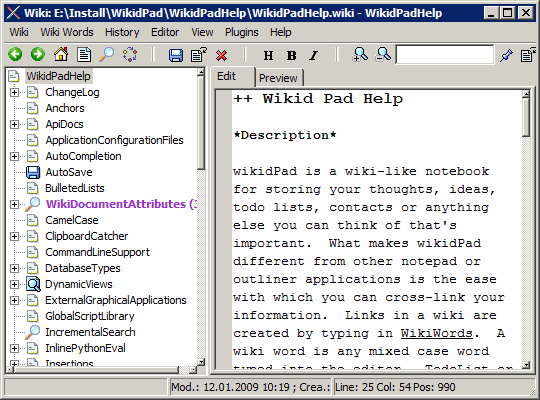![]() Wikipedia is probably most known case where key technology is so close and understandable to end-user. Easy text markup and in-browser editing turned out to be great combination.
Wikipedia is probably most known case where key technology is so close and understandable to end-user. Easy text markup and in-browser editing turned out to be great combination.
There are a lot of apps that try to adopt wiki for local tasks. WikidPad is one of the very few where wiki concept was implemented well and even surpassed.
What it does
WikidPad has no clear purpose. It has clear function – to be ultimate engine for storing and organizing texts of any kind .

It may seem simplistic at first glance. Type some text, add some links… And see magic happen.
Text
At first your wiki is collection of text. You have two options for saving – SQLite database or plain text files. I prefer plain text because that way files are more accessible and easily modifiable outside of WikidPad (which has absolutely no problem with other application make changes).
Markup is simple but has most common stuff like headings (multiply levels), lists, bold/italic, etc. You can easily embed images as well.
Links
After you have initial pile of text you can start linking around wiki-style. Basically when you type something that is same as name of existing page it gets linked to that page. Or you can create link to nowhere first and follow it to get empty page to be filled with text.
Around here really useful stuff starts.
Structure
Using your links WikidPad fully automatically generates tree view with hierarchy of pages. Without any effort you get clear structure that works exactly the way you want it to . Change something and tree changes.
- Need table of contents? Create a page, throw some links on it and pages would become sub-pages for it in tree.
- Want to work with tiny parts but see big picture once in a while? Embed multiply small pages in single big mashup.
- Have tiny bits of info (like definitions) scattered through all of your data? Tag them with custom attribute, assign specific icon and get neat tree branch with all of them in single place.
- Want to mark parts that need more work? Easily construct simple (or complex) to-do list.
There is no need to plan or fit your data into structure. You just use it and WikidPad will take care of structure for you. It’s somewhat like mind maps just more suited for working with large amounts of text instead of short bursts.
Export
There are few export options to tinker with but basic idea is that you can take wiki (no matter how complex) and get HTML page/set of pages from it, while keeping all markup and internal linking . HTML is second only to plain text in compatibility, you can easily use exported version from straight web-publishing to taking on-the-go in any browser-equipped device.
Development
WikidPad is cross-platform, open source and freeware. Unfortunately it has little mainstream appeal (plain text and freeform structuring may excite techie in me but I get it that most people won’t be very interested). Development is rather slow with seriously weird versioning history – current stable version is 1.8 release candidate 19 . I don’t really think there is other project that has managed to output almost twenty release candidates and still not reach second digit release.
Also despite support for plugins (in Python WikidPad is programmed with) there are very few of them.
Overall
WikidPad is hardly application for everyone. However for those that need to work with text of any kind it is dumbfoundingly good . Not portable right after install but help wiki (bundled in installation) has instructions for converting it to completely portable mode. Search it for USB .
PS I had read some concerns in the past that WikidPad is not network-friendly enough (unlike other wiki solutions). Hint – try to add Dropbox and you may get seriously powerful text collaboration tool with integrated web-publishing on top.
Home&download http://wikidpad.sourceforge.net/
Additional stuff http://wikidpad.python-hosting.com/
MK #
Rarst #
Make PHP code self-explaining with PHPXref | Rarst.net #
Developer’s Tips&Tricks (DTT) – code snippet manager | Rarst.net #